Mastering MODX: Using Category Search

There are three separate types of SEARCH for PERFORMANCES:
- “Performance Category Search”
- “Performance Merge”
- “Part Search”
The results will be in shown in blue or green font. Confusing? Let our own Bad Mister clarify for you. In this article he’ll explain why and how the Category Search Function can help you “know” what you are looking at when you use this most powerful MODX feature:
This “search” is used when you wish to find a new Performance – this will replace the current selection. When searching, you can view just the data you are interested in viewing. MULTI PART Performances appear in blue and the SINGLE PART Performances appear in green.
Performance Category Search
This type of Performance search appears when you press the [CATEGORY] button while the cursor highlights the Performance Name; from what MODX considers the “Home” screen (the little house icon appears in blue in the upper left corner of the screen). This search will show you other complete Performance programs which will completely replace the currently selected one:
- Press [CATEGORY]. The top line of the screen reads: “Performance Category Search”.
- Touch the “Bank/Favorite” option to view a dropdown revealing the Bank options: “All”, “Favorites”, “Preset”, “User”, followed by your eight installed Library Banks (if any). Alternatively, you can repeatedly press [CATEGORY] to toggle through the options one-by-one.
- Press and hold [CATEGORY] to return the BANK search to “All”. Use the “Attribute” option to refine the search by technology or type of behavior: “All”, “AWM2”, “FM-X”, “AWM2+FM-X”, “MC”, “SSS”, “Single”, “Multi”.
- All – every Performance associated with your MODX no matter the Bank.
- AWM2 – the sampled based engine, only.
- FM-X – the Frequency Modulation Engine, only.
- AWM2+FM-X – combination Performances, only.
- MC – Motion Control, means those featuring Arpeggios, Motion Sequences, and/or Super Knob automation.
- SSS – Seamless Sound Switch (Performance contains 4 Parts or less, under KBD CTRL).
- Single – one Part instrument.
- Multi – multiple Parts combined to make an instrument or form an ensemble.
You can enter characters in the Text box (magnifying glass) and/or use the Main and Sub Category listings.
Along the bottom of the screen, you can sort the results shown: Default (as listed in the Data List), Name (alphabetical or reverse) or Date (useful for User created data):
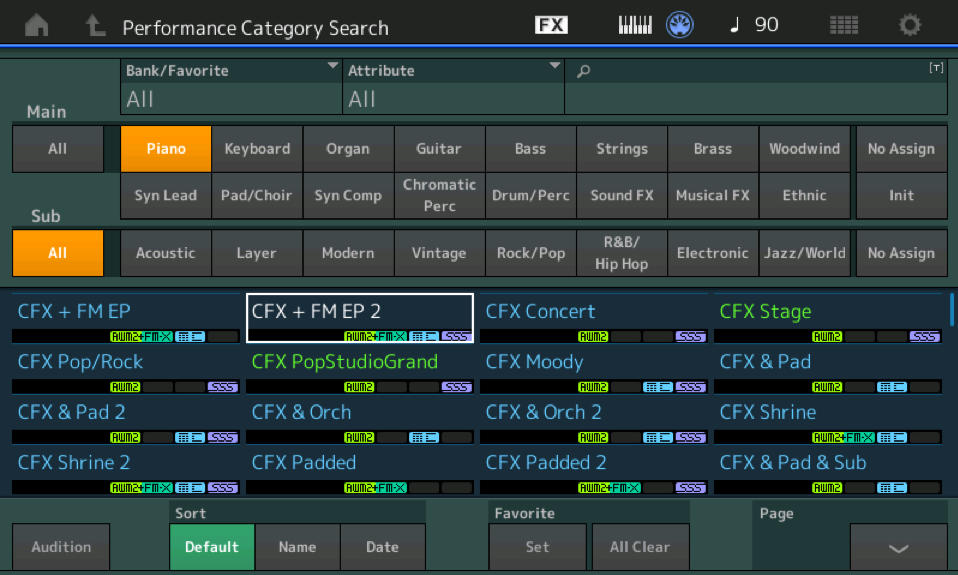
Performance Merge
This is the type of Category Search initiated when you have added a new Part by touching the (“+”) icon on an empty Part slot. You may see a “+” icon on the first 8 PARTS of a MODX Performance – these are the PARTs that can be linked under simultaneous Keyboard Control (KBD CTRL).
From the [PERFORMANCE (HOME)] screen, touch the first available slot (“+”) to ADD a new Part. The top of the screen will identify the Search as a “PartX – Performance Merge”. This means you could select an additional Single (green) or Multi (blue) Part program and add it to the original Parts already in the Performance. They are then “merged” into a new Multi Part (KBD CTRL) program.
The screenshot below appears when entered from the [HOME] screen of a two-PART PERFORMANCE. This means, on the [HOME] screen a “+” was touched in Part 3. For example, if you attempted to ADD (+) a PART to the “CFX +EP 2” Performance you would touch the empty slot (+) to launch this Merge type Search.
It is ready to MERGE “All” (Source) the PARTs of the “FM CS80 Brass” Performance to the existing data. The screen reads: “Part 3 – Performance Merge”:
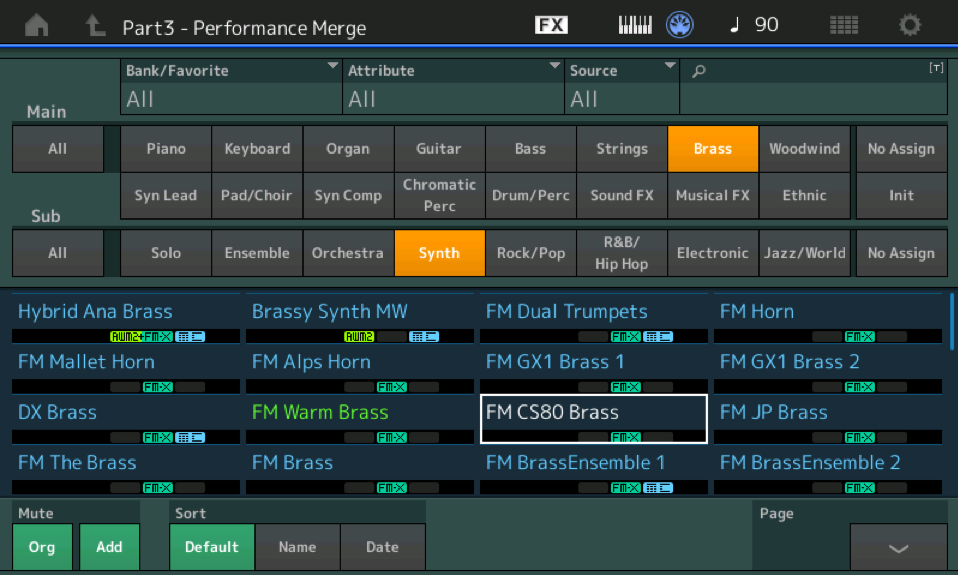
When a new Part, or Parts, are merged together with an existing Performance, they were two programs – they are now merged and become one Performance.
It is important to understand: There can be only one, Multi Part KBD CTRL Performance. By merging a two-Part Performance with the existing two Parts, the new “merged” Performance will now contain four Parts.
While the Merge screen is shown, you can set the BANK, ATTRIBUTES, and SOURCE to narrow your search. The “Source” can be “All”, meaning all of the Parts from a selected Multi Part program (listed in blue); or a selected Single Part program (listed in green) Part 1-16; you can also designate any specific Part from any Performance. This means you can merge an entire Multi Part program or just any one of the Parts in this operation.
Notice in the lower left corner of the Performance Merge screen you can “Mute” the original Parts (“Org”), and, audition just the Part(s) you highlight in the Search view. You can also “Mute” the Search Part(s) (“Add”) while hearing just the originals. This makes balancing and trying out things while merging much more practical.
For example, maybe you only want the mechanical Rhodes piano noise from Part 5 from the Factory Performance “Rd 1 Gallery”. You could merge just that component building block that works as KEY-OFF noise (Source = Part5). Or perhaps you are interested in just the FM EP that you know is in the “CFX + FM EP 2” Performance at PART #2. Perhaps the drum kit you assemble for a multi-track session would be perfect in another composition, you can recall any single Part from any program. You can recall “All” Parts from any Performance.
Part Category Search
The third type of Search for Performances appears if you enter [CATEGORY] by searching from an already occupied individual Part location, which would be the case if you start with the INIT > “MULTI/GM” template (shown below):
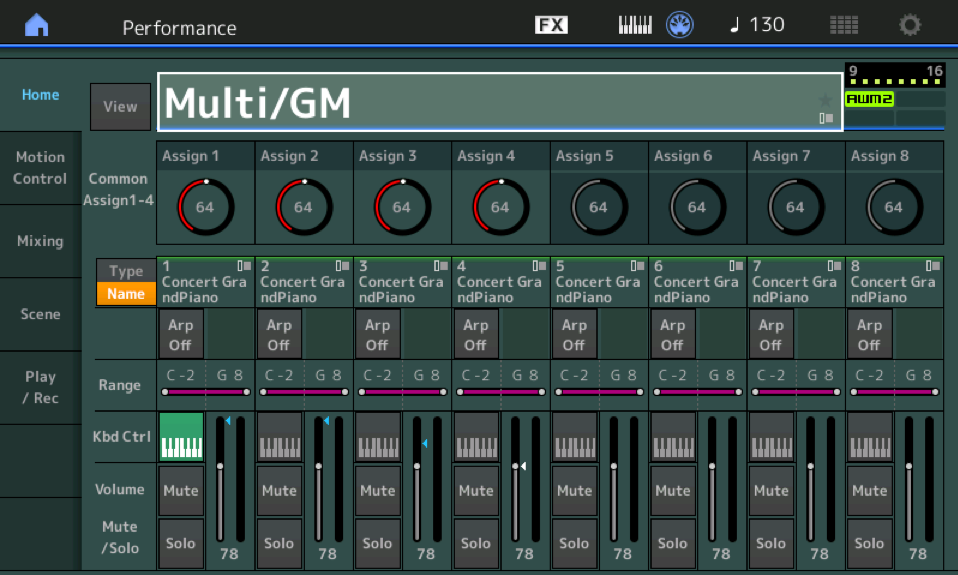 Starting from the MULTI/GM template would be the logical place to begin when using the MODX as a multi-timbral tone engine – for example, when starting a session with a computer-based DAW software. There are two methods to arrive at the “PART – Category Search”:
Starting from the MULTI/GM template would be the logical place to begin when using the MODX as a multi-timbral tone engine – for example, when starting a session with a computer-based DAW software. There are two methods to arrive at the “PART – Category Search”:
- Touch the box with the PART “Type/Name” (Concert GrandPiano). A pop-in menu comes in from the left. Select “Category Search”.
- You can also activate the Part Category search anytime you have a PART *selected*: Hold [SHIFT] + [CATEGORY].
For example, Press the [PART SELECT—MUTE/SOLO] button. In the screen, tap “Select” > PART 1-8 or 9-16 > then select the PART number. Once the PART is identified you can press [SHIFT] + [CATEGORY] to execute the PartX Category Search.
Under these conditions and you will see the “PartX Category Search” screen (as shown below). Again, you can refine your search using BANK, and ATTRIBUTE will let you view “All”, “Single” or “Multi”. Additionally, you can set the SOURCE Part, but this time you are not able to select “All” as the SOURCE (we are not ‘merging’, we are ‘replacing’ an existing single Part). You can, however, search for any one Part from any Performance – be it from within a MULTI PART or just a SINGLE PART. You might want to access just the first violin section from the “Seattle Sections” (PART 1), or just the Drum Kit from an existing Performance. (“CFX + FM EP”, we know is a MULTI Part Performance, for example, it appears, but as separately accessible components):
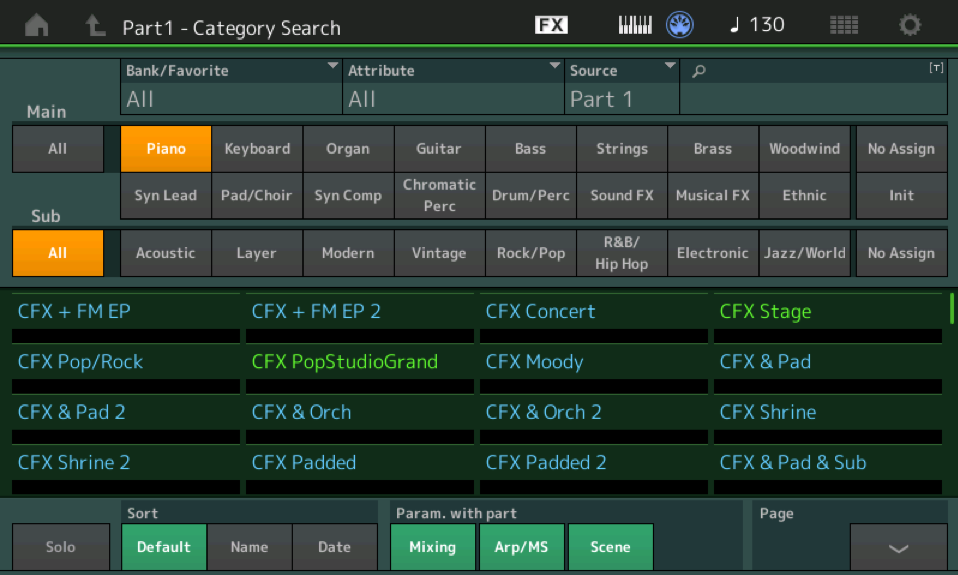
There is an issue here, however. Let’s say you import just PART 1 of the “CFX + FM EP” (shown above) – because this PERFORMANCE uses multiple PARTS to create a massive 9-way velocity switching piano sound, PART 1 is only a partial piano. In other word, it is only responsible for Velocities from 46-127 and without PARTS 2, 3 and 4 it is not a completely playable instrument sound… not necessarily what you want if you are looking for a whole playable piano sound. But how can you know whether you are importing a fully playable layer or just an incomplete component Part?
Wouldn’t it be useful to view just those Single programs that are fully playable Parts, separate from those that are not? Here’s how…
Initially, MODX shows you all of the potential ‘Source’ programs, if you set the ATTRIBUTE to “Single”, however, the search results will eliminate the Multi Part PERFORMANCES and be limited to only those Single Part programs that are full, complete playable layers! This is necessary because some of the Multi Parts when selected alone do not play from all key ranges, and some do not respond to all velocities. Simply use the ATTRIBUTE to search “Single”. This is completely logical and very useful!
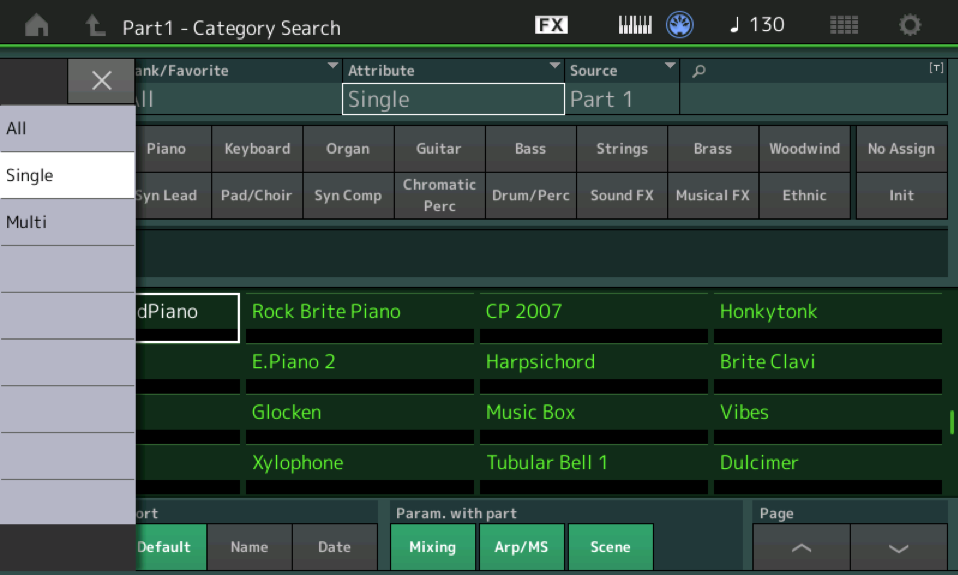
The “Part – Category Search” shown above, includes the “Parameter with Part” feature that allows the PART selected to join this PERFORMANCE with the same MIXING settings, the same ARPEGGIOs and MOTION SEQUENCEs assigned, and/or the same SCENE settings from its previous PERFORMANCE Home. This is very useful when attempting to duplicate the previous behavior of this PART in your new PERFORMANCE. If, however, you wish to bring the PART in without its previous programming – simply deactivate the option in question.
Translation: For example, if you would prefer the sound you select inherit current PERFORMANCE settings (say you are substituting a BASS sound in a SPLIT PERFORMANCE) then you do not want to bring along the previous MIXING settings. – particularly if previously the PART was mapped across the entire key range. By deactivating ‘MIXING” (grey) your current SPLIT Note Limits will be respected!
The default is for “Parameter with part” to be active (green). Iif you would rather assign new Mixing settings, new Arpeggios, create new Motion Sequences, and store new Scene snapshots concerning this instrument sound in its new Home, you can opt out by deselecting these options before making your Search selection final.
If you have activated the Zone Master feature in UTILITY, a Part can, additionally, bring along the Zone Settings using the “Parameter with Part” option. This is very useful when you wish to duplicate work you have previous done:
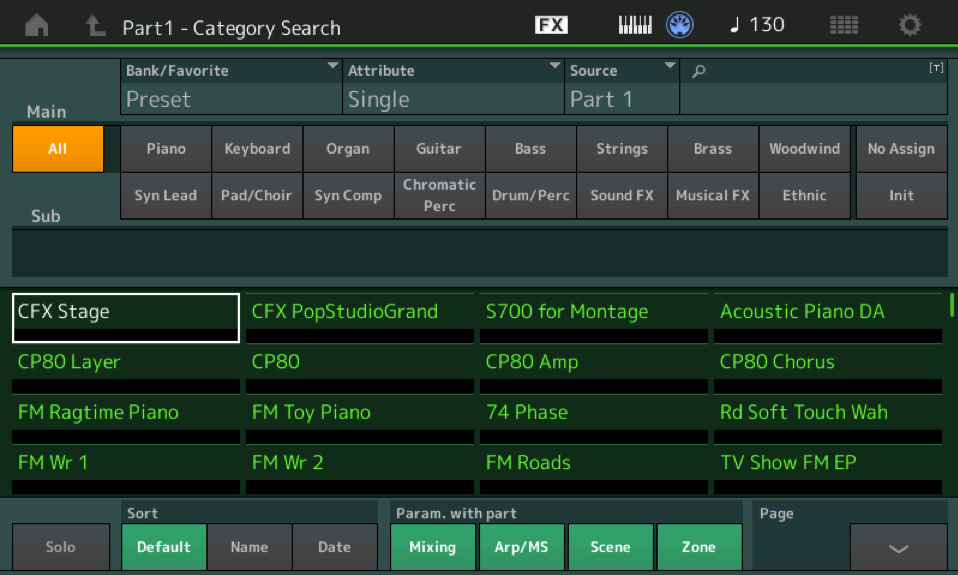
Have more questions or want to continue the conversation about MODX’s Category Search? Join us on the Forum here!
Keep Reading
© 2024 Yamaha Corporation of America and Yamaha Corporation. All rights reserved. Terms of Use | Privacy Policy | Contact Us